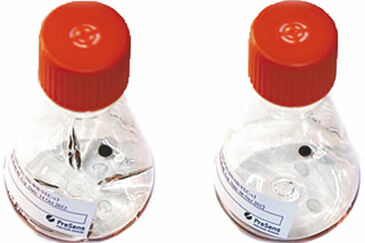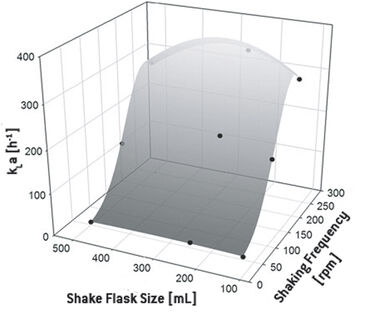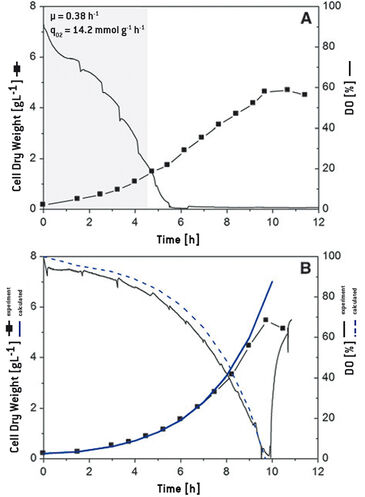Watch tutorials, webinars and informative videos about PreSens optical sensor systems.
A New Method for Predicting Oxygen Supply during Aerobic Growth
Measurements with the SFR Shake Flask Reader allow kLa determination and reliable design of culture conditions in disposable shake flasks

S. Schiefelbein1, A. Fröhlich1, G. T. John2, F. Beutler2, C. Wittmann1, and J. Becker1
1Institute of Biochemical Engineering, Technische Universität Braunschweig, Germany
2PreSens Precision Sensing GmbH, Germany
Dissolved oxygen (DO) is a key parameter during aerobic cultivation and due to its low solubility oxygen can become limiting under certain culture conditions. In this study a new method has been developed for predicting oxygen transfer rate, oxygen saturation and maximum cell concentration under different culture conditions in disposable shake flasks. Therefore, new mathematical correlations for determining the volumetric gas-liquid mass transfer coefficient (kLa) from filling volume, vessel size, and agitation speed have been established. Oxygen measurements were conducted with the SFR Shake Flask Reader. Following tests with Corynebacterium glutamicum showed that with this new method a reliable design of culture conditions could be realized, and maximum possible cell concentration without limitation could be predicted.
Shake flasks offer several advantages, like e. g. easy handling, and high throughput, and are therefore broadly used in research and industry. This is why dissolved oxygen concentration and mass transfer in shake flasks have already been investigated in several studies. However, this information has never been used for preliminary considerations in experiment design, or the prediction of DO in aerobic cultivation, though this would have significant advantage and prevent failure due to oxygen limitations. In this study we developed a method for the reliable prediction of oxygen saturation during aerobic growth. As there is a growing market for disposable cultivation vessels with integrated sensors, our experiments focused on this type of plastic shake flasks. We conducted a systematic investigation on kLa in disposable shake flasks with and without baffles, and oxygen monitoring was realized with the SFR Shake Flask Reader allowing online monitoring in the vessels. The resulting mathematical correlations for kLa calculation have then been used on a model cultivation with C. glutamicum, and maximum cell concentration that could be obtained without oxygen limitation was determined beforehand.


Materials & Methods
kLa was quantified in baffled and non-baffled shake flasks of different size (125, 250, 500 mL) with integrated oxygen and pH sensors (SFS Sensor Flasks, PreSens). Measurements were conducted in 100 mM phosphate buffer (pH 7.0) at 30 and 37 °C in an orbital shaker with shaking diameter of 50 mm. DO monitoring was realized with the SFR Shake Flask Reader (PreSens). The shake flasks were equilibrated with buffer and Co(NO3)2 (0.1 mM). Complete oxygen depletion was obtained by addition of 200 gL-1 Na2SO3 stock solution. The working volumes (10 - 40 % max. filling volume) and shaking frequencies (50, 150, 250 rpm) were varied and all measurements performed in triplicate. kLa was determined between 20 - 90 % of oxygen saturation using Berkley MADONNA (Ver. 8.0.1). For kLa estimation, empirical correlations between flask size, shaking frequency, and kLa were compiled based on experimental data. Mathematical fitting either used the Gaussian function or parabolic function [1]. C. glutamicum ATCC 13032 was cultivated with mineral salt medium. Cultures were grown in 250 mL baffled shake flasks (SFS, PreSens) at 30 °C, 150 rpm with a filling volume of either 10 or 30 %. The latter was used to determine the specific growth rate and specific oxygen uptake rate. These experimentally determined values for growth and oxygen uptake were applied to predict the increase of biomass concentration and decrease of DO during growth of C. glutamicum at 30 °C, 150 rpm in 250 mL shake flasks at 10 % filling volume.
kLa Quantification in Shake Flasks
kLa was determined by online oxygen monitoring in buffer-filled baffled and non-baffled shake flasks. Oxygen was completely removed by the addition of Na2SO3 to the system. When the redox-reaction catalyzed by Co2+ was completed, dissolved oxygen inside the flasks increased which could be used to determine kLa for the given conditions. For the investigated shake flasks remarkably high kLa values of up to 350 h-1 were determined. For non-baffled shake flasks the kLa was in general lower, with max. kLa values of 100 h-1 [1]. The shaking frequency had the most significant impact on oxygen transfer. Vessel size had hardly any statistically relevant influence on kLa of non-baffled shake flasks, but showed some effect on kLa in baffled flasks. A temperature rise from 30 to 37 °C barely influenced the kLa. Nevertheless, an individual correlation was established for 30 and 37 °C for each investigated filling volume. In Figure 2 this is shown for baffled shake flasks at 30 °C with 10 % filling volume. Optimal parameter estimation was obtained for a Gaussian fitting of the kLa values for baffled flasks and for parabolic fitting of kLa values for non-baffled flasks.
Growth and Oxygen Consumption of C. glutamicum
Figure 3 A shows growth and oxygen consumption of C. glutamicum culture in 250 mL shake flasks at 30 % filling volume and 150 rpm shaking frequency. It can be observed that DO dropped very fast and became limiting after 4 hours. Growth and oxygen uptake were determined to 0.38 h-1 and 14.2 mmol g-1 h-1 respectively. These values were used for predicting the time course of cell growth and DO for C. glutamicum cultivation at another, so far untested condition. Calculations were made for an experimental set-up in 250 mL baffled shake flasks with 10 % filling and a shaking frequency of 150 rpm. kLa was calculated to 190 h-1 and with an inoculum concentration of 0.2 g CDW L-1 the time course of cell growth was determined as depicted in Figure 3 B (solid blue line); considering all parameters DO was calculated (dashed blue line). When conducting the experiment and monitoring culture performance it could be verified that oxygen consumptions were indeed well prognosticated. Experimental and predicted values were almost identical. The anticipated cell concentration at limiting oxygen supply (4.3 g L-1) also matched with the experimentally achieved cell concentrations of 4.6 ± 0.3 g L-1 at DO of 20 %.
Conclusion
Results of this study clearly show that this method can be applied to predict optimal culture conditions and oxygen consumption in disposable shake flasks. With the established correlations kLa calculation can be transferred from the buffer-based system to standard shake flask cultivation. The ability to predict the oxygen availability for specific experimental set-ups can significantly improve the design of experiments. The SFR system is especially designed for oxygen monitoring in disposable shake flasks and proved a valuable tool in this investigation, providing the basic data for the development of this new method and for its later verification.
Application note adapted from
[1] S. Schiefelbein et al., Biotechnol Lett, 2013: Oxygen supply in disposable shake-flasks: prediction of oxygen transfer rate, oxygen saturation and maximum cell concentration during aerobic growth.


